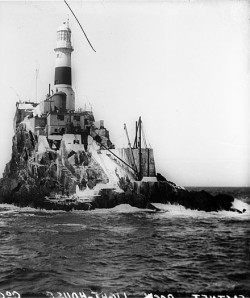What disaster inspired the construction of the first modern lighthouse?
 November 10, 1847 — The passenger ship Stephen Whitney wrecked today in thick fog off the southern coast of Ireland, killing 92 of the 110 on board.
November 10, 1847 — The passenger ship Stephen Whitney wrecked today in thick fog off the southern coast of Ireland, killing 92 of the 110 on board.
The disaster resulted in the construction the Fastnet Rock lighthouse, which began in 1853 and produced a light on January 1, 1854. Designed by George Halpin, it stands 4.5 miles southwest of Cape Clear and southwest of Mizen Head.
Known as The Teardrop of Ireland (because it is the last sight of Ireland for emigrants sailing to America), it stands about around 91 feet tell and the cost was £17,390.
The original lighthouse had an oil burning lamp of 38 kilocandelas; in contrast modern lighthouses typically produce 1,300 kilocandelas. In 1883, an explosive fog signal was installed, which electrically detonated a small charge of guncotton every five minutes.
Sources
Words of Wisdom
[Fastnet Rock lighthouse] has witnessed excitement, and tragedy. The Titanic sailed past on her maiden voyage to New York in 1912. On May 4th 1915 its keepers, probably peering out from the elegant balcony on the seventh floor, saw a German submarine cheekily surface to buy the morning's catch from a local Irish fishing boat. According to Éamon Lankford, a local historian who wrote Fastnet Rock in 2004, they warned the Royal Navy, but to no avail. The same day, the U-boat sunk the Lusitania, killing 1,200 civilians on their way from America.





